Organisational Behaviour Report: Waitrose, Culture, Politics, Power
VerifiedAdded on 2021/02/19
|20
|6224
|91
Report
AI Summary
This report provides an in-depth analysis of organisational behaviour within Waitrose, a UK-based retail store. It examines the influence of culture, power, and politics on employee behaviour, using Hofstede's Cultural Dimensions Theory and Handy's Model to assess cultural aspects. The report explores various motivation techniques, including Herzberg's Two-Factor Theory and McClelland's Theory, for both individuals and teams. It contrasts effective versus ineffective team dynamics and discusses group development theories. Furthermore, the report highlights different organisational behaviour philosophies applicable to Waitrose to improve business situations, covering topics like power dynamics (French and Raven Model) and the impact of positive and negative politics. Overall, the report offers a comprehensive overview of how organisational behaviour principles are applied and can be optimized within Waitrose.
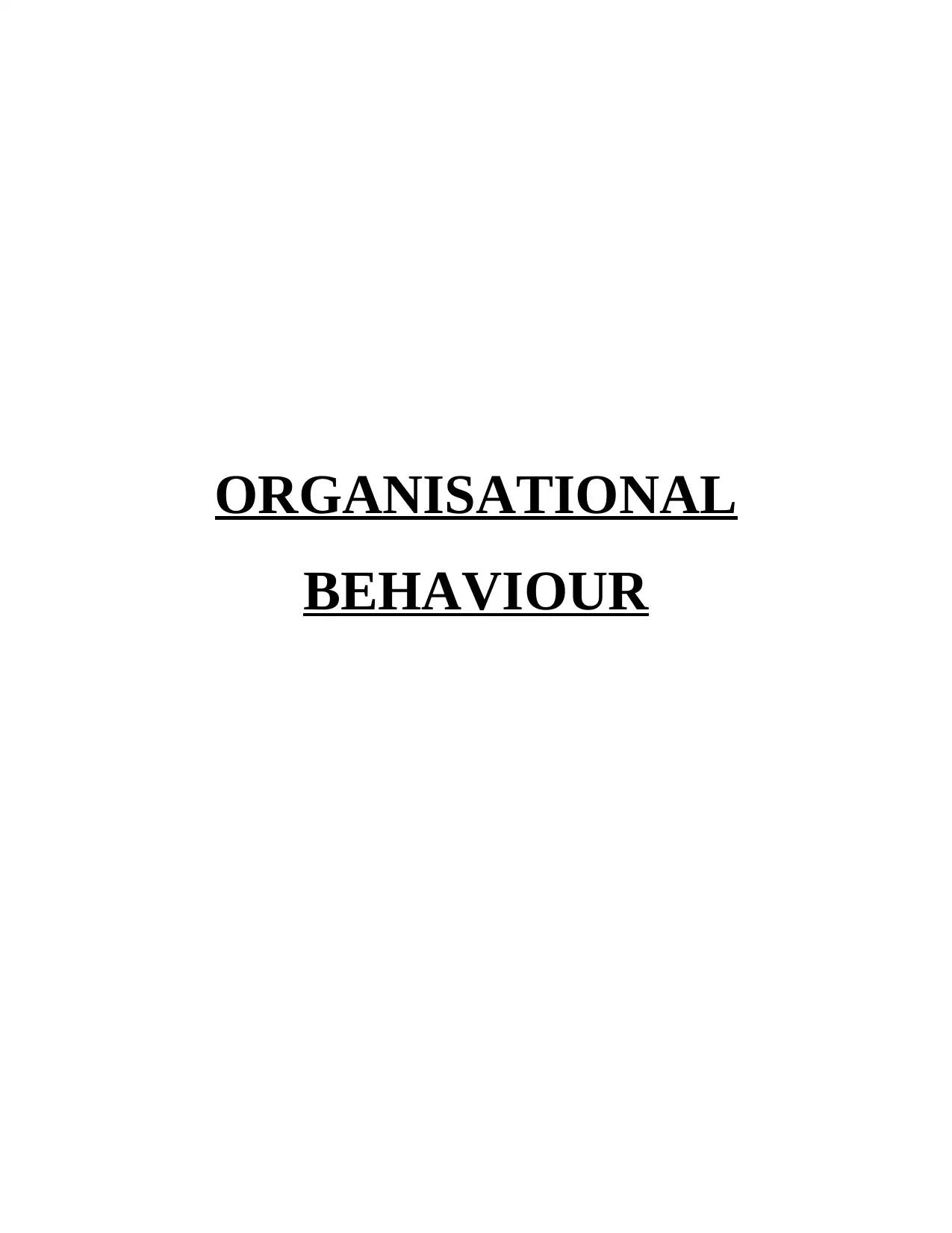
ORGANISATIONAL
BEHAVIOUR
BEHAVIOUR
Paraphrase This Document
Need a fresh take? Get an instant paraphrase of this document with our AI Paraphraser

Table of Contents
INTRODUCTION...........................................................................................................................3
MAIN BODY...................................................................................................................................3
LO 1.................................................................................................................................................3
P 1 Influence of culture, politics and power on behaviour in Waitrose.................................3
LO 2.................................................................................................................................................7
P 2 Motivation techniques and models for individuals and teams.........................................7
LO 3...............................................................................................................................................10
P 3 Effective team as opposed to ineffective team...............................................................10
LO 4...............................................................................................................................................15
P 4 Philosophies and concepts of organization behaviour...................................................15
CONCLUSION..............................................................................................................................17
REFERENCES..............................................................................................................................19
INTRODUCTION...........................................................................................................................3
MAIN BODY...................................................................................................................................3
LO 1.................................................................................................................................................3
P 1 Influence of culture, politics and power on behaviour in Waitrose.................................3
LO 2.................................................................................................................................................7
P 2 Motivation techniques and models for individuals and teams.........................................7
LO 3...............................................................................................................................................10
P 3 Effective team as opposed to ineffective team...............................................................10
LO 4...............................................................................................................................................15
P 4 Philosophies and concepts of organization behaviour...................................................15
CONCLUSION..............................................................................................................................17
REFERENCES..............................................................................................................................19

INTRODUCTION
Organizational Behaviour can be defined as a study of individual as well as team
performance in an organizational setting where it is examined that how employees are behaving
and interacting with other employees and senior management (Borkowski, 2015). In this report,
influence of culture, power and politics on Waitrose which is a UK based retail store has been
observed and various motivation theories for employees have been discussed for individuals as
well as teams. Further, in this report, effective versus ineffective team has been discussed and
different group development theories will be discussed. Lastly, this report will also highlight the
various philosophies that can be applied in Waitrose in order to improve a business situation.
MAIN BODY
LO 1
P 1 Influence of culture, politics and power on behaviour in Waitrose.
In an organization as wide as Waitrose, there are many aspects that collectively form an
organization. The ethics, working culture, power and politics are a few of these aspects which
ensure that the organizational practices motivate employees.
Culture:- Culture in organizational context can be defined as shared values, beliefs or practices
that employees working in a same workplace adopt and implement to interact with each other. At
Waitrose, in order to ascertain the influence level of culture, Hofstede's Culture Dimension
Theory and Handy's Model can be implemented. There are five major dimensions i.e.:- Power Distance Index (PDI) under which variation in power that is given to employees
at different levels is ascertained from view point of lower level employees. Higher PDI
index depicts clear distribution of hierarchy (Kanfer and Chen, 2016). In Waitrose, there
is a moderate PDI were employees have authority that they require for completing their
job roles, yet there is no sufficient power available. Individual employees at Waitrose get
motivated by the appropriate authority they have and as a team also they are benefited but
the difference in authority level as per the difference in position brings feeling of
inferiority in team members. Individualism v/s Collectivism is another dimension where a collectivism depicts the
integration of employees of a company with each other and individualism shows the
importance that employees give to themselves as individuals. At Waitrose, the employees
Organizational Behaviour can be defined as a study of individual as well as team
performance in an organizational setting where it is examined that how employees are behaving
and interacting with other employees and senior management (Borkowski, 2015). In this report,
influence of culture, power and politics on Waitrose which is a UK based retail store has been
observed and various motivation theories for employees have been discussed for individuals as
well as teams. Further, in this report, effective versus ineffective team has been discussed and
different group development theories will be discussed. Lastly, this report will also highlight the
various philosophies that can be applied in Waitrose in order to improve a business situation.
MAIN BODY
LO 1
P 1 Influence of culture, politics and power on behaviour in Waitrose.
In an organization as wide as Waitrose, there are many aspects that collectively form an
organization. The ethics, working culture, power and politics are a few of these aspects which
ensure that the organizational practices motivate employees.
Culture:- Culture in organizational context can be defined as shared values, beliefs or practices
that employees working in a same workplace adopt and implement to interact with each other. At
Waitrose, in order to ascertain the influence level of culture, Hofstede's Culture Dimension
Theory and Handy's Model can be implemented. There are five major dimensions i.e.:- Power Distance Index (PDI) under which variation in power that is given to employees
at different levels is ascertained from view point of lower level employees. Higher PDI
index depicts clear distribution of hierarchy (Kanfer and Chen, 2016). In Waitrose, there
is a moderate PDI were employees have authority that they require for completing their
job roles, yet there is no sufficient power available. Individual employees at Waitrose get
motivated by the appropriate authority they have and as a team also they are benefited but
the difference in authority level as per the difference in position brings feeling of
inferiority in team members. Individualism v/s Collectivism is another dimension where a collectivism depicts the
integration of employees of a company with each other and individualism shows the
importance that employees give to themselves as individuals. At Waitrose, the employees
⊘ This is a preview!⊘
Do you want full access?
Subscribe today to unlock all pages.

Trusted by 1+ million students worldwide

of the company are closely integrated with each other and assist each other growing
collectively. As an individual sometimes this presents as a complexity because employees
are not able to garner any personal benefits but as a team this is an extremely motivating
factor since it ensures collective growth of all the team members. Uncertainty Avoidance is the third dimension where lower index indicates the
acceptance level of employees towards something unexpected or unaccounted and higher
index depicts that employees are rigid and do not easily adjust themselves as per the
changing situations (Kinicki and Fugate, 2017). In Waitrose, the index score is moderate
where the employees accept and adjust to changes but slowly. At an individual adjusting
to the emerging challenges is a challenging task and employees at Waitrose do not adjust
to it easily and it gets further complicated for teams since there are employees with varied
personalities and these affect each other. Masculinity v/s Femininity is the fourth dimension which identifies the gap between
female and male empowerment. A male dominated culture gives more power to males
and female dominated culture gives extra power to females. At Waitrose, a balanced
culture is adopted where both male and female employees are given equal opportunities
and rewards (Lăzăroiu, 2015). Employees as an individual as well as team are highly
motivated due to equal male female employee treatment.
Long Term v/s Short Term Orientation is the last dimension under which measures
integration of past traditions and values with currently changing environment. A lower
index value indicates that employees honour traditions but also inculcate modern
practices and changing culture but a higher index depict that employees are resilient and
do not easily leave their traditions and values. At Waitrose, orientation index is lower i.e.
they accept and integrate modern practices with older ones (McShane and Glinow, 2017).
Employees as individuals are extremely motivated but sometimes while working in teams
orientation problem might arise between older and younger team members.
Thus, by application of Hofstede's Cultural Model it could be determined that while some
aspects of Waitrose are culturally strong like equal male-female treatment, short term orientation
etc., there are certain problems also like moderate PDI which should rather be lower. However,
the overall cultural aspect of the company is strong and influences the behaviour of employees as
a team and as an individual in an organization in positive manner.
collectively. As an individual sometimes this presents as a complexity because employees
are not able to garner any personal benefits but as a team this is an extremely motivating
factor since it ensures collective growth of all the team members. Uncertainty Avoidance is the third dimension where lower index indicates the
acceptance level of employees towards something unexpected or unaccounted and higher
index depicts that employees are rigid and do not easily adjust themselves as per the
changing situations (Kinicki and Fugate, 2017). In Waitrose, the index score is moderate
where the employees accept and adjust to changes but slowly. At an individual adjusting
to the emerging challenges is a challenging task and employees at Waitrose do not adjust
to it easily and it gets further complicated for teams since there are employees with varied
personalities and these affect each other. Masculinity v/s Femininity is the fourth dimension which identifies the gap between
female and male empowerment. A male dominated culture gives more power to males
and female dominated culture gives extra power to females. At Waitrose, a balanced
culture is adopted where both male and female employees are given equal opportunities
and rewards (Lăzăroiu, 2015). Employees as an individual as well as team are highly
motivated due to equal male female employee treatment.
Long Term v/s Short Term Orientation is the last dimension under which measures
integration of past traditions and values with currently changing environment. A lower
index value indicates that employees honour traditions but also inculcate modern
practices and changing culture but a higher index depict that employees are resilient and
do not easily leave their traditions and values. At Waitrose, orientation index is lower i.e.
they accept and integrate modern practices with older ones (McShane and Glinow, 2017).
Employees as individuals are extremely motivated but sometimes while working in teams
orientation problem might arise between older and younger team members.
Thus, by application of Hofstede's Cultural Model it could be determined that while some
aspects of Waitrose are culturally strong like equal male-female treatment, short term orientation
etc., there are certain problems also like moderate PDI which should rather be lower. However,
the overall cultural aspect of the company is strong and influences the behaviour of employees as
a team and as an individual in an organization in positive manner.
Paraphrase This Document
Need a fresh take? Get an instant paraphrase of this document with our AI Paraphraser
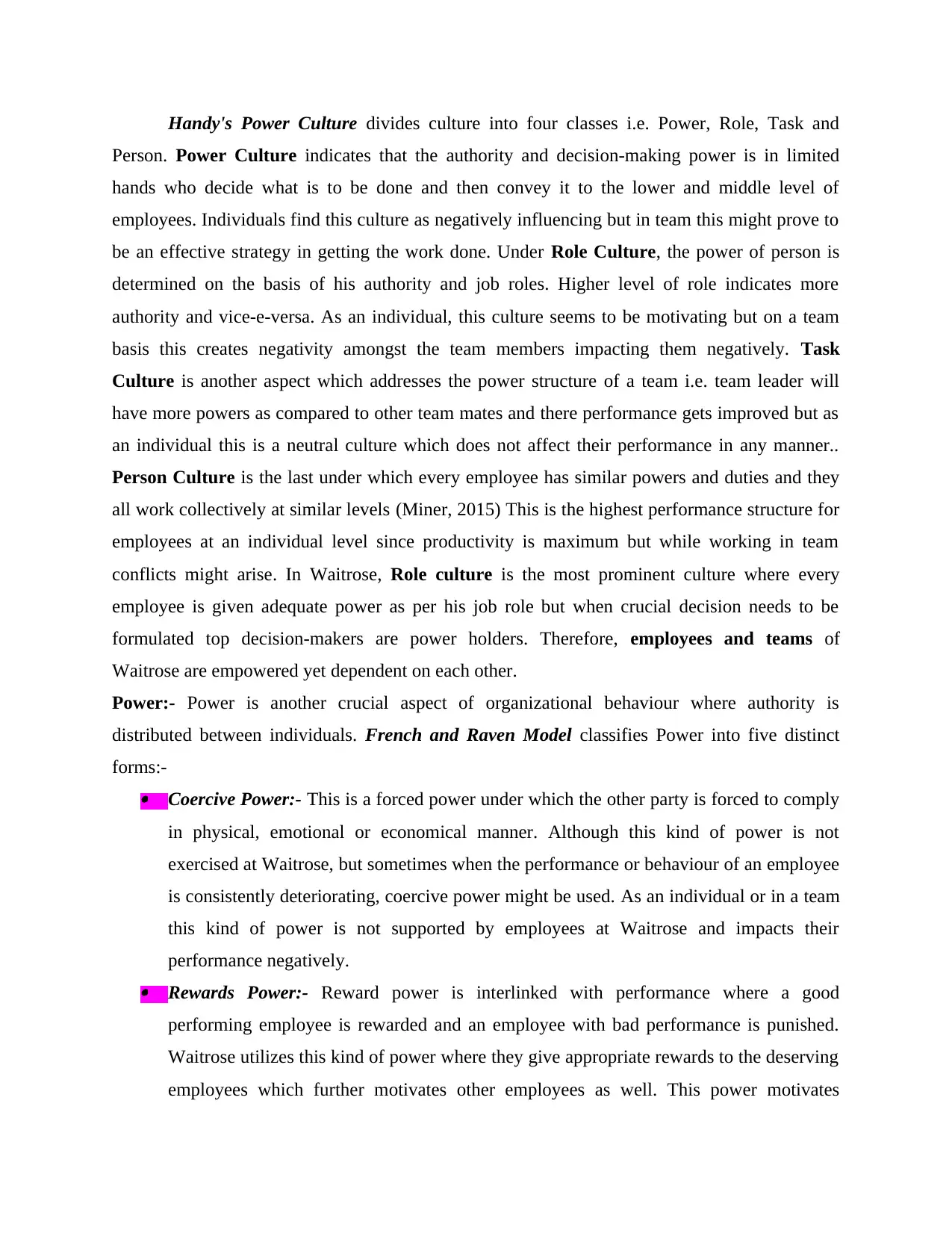
Handy's Power Culture divides culture into four classes i.e. Power, Role, Task and
Person. Power Culture indicates that the authority and decision-making power is in limited
hands who decide what is to be done and then convey it to the lower and middle level of
employees. Individuals find this culture as negatively influencing but in team this might prove to
be an effective strategy in getting the work done. Under Role Culture, the power of person is
determined on the basis of his authority and job roles. Higher level of role indicates more
authority and vice-e-versa. As an individual, this culture seems to be motivating but on a team
basis this creates negativity amongst the team members impacting them negatively. Task
Culture is another aspect which addresses the power structure of a team i.e. team leader will
have more powers as compared to other team mates and there performance gets improved but as
an individual this is a neutral culture which does not affect their performance in any manner..
Person Culture is the last under which every employee has similar powers and duties and they
all work collectively at similar levels (Miner, 2015) This is the highest performance structure for
employees at an individual level since productivity is maximum but while working in team
conflicts might arise. In Waitrose, Role culture is the most prominent culture where every
employee is given adequate power as per his job role but when crucial decision needs to be
formulated top decision-makers are power holders. Therefore, employees and teams of
Waitrose are empowered yet dependent on each other.
Power:- Power is another crucial aspect of organizational behaviour where authority is
distributed between individuals. French and Raven Model classifies Power into five distinct
forms:- Coercive Power:- This is a forced power under which the other party is forced to comply
in physical, emotional or economical manner. Although this kind of power is not
exercised at Waitrose, but sometimes when the performance or behaviour of an employee
is consistently deteriorating, coercive power might be used. As an individual or in a team
this kind of power is not supported by employees at Waitrose and impacts their
performance negatively. Rewards Power:- Reward power is interlinked with performance where a good
performing employee is rewarded and an employee with bad performance is punished.
Waitrose utilizes this kind of power where they give appropriate rewards to the deserving
employees which further motivates other employees as well. This power motivates
Person. Power Culture indicates that the authority and decision-making power is in limited
hands who decide what is to be done and then convey it to the lower and middle level of
employees. Individuals find this culture as negatively influencing but in team this might prove to
be an effective strategy in getting the work done. Under Role Culture, the power of person is
determined on the basis of his authority and job roles. Higher level of role indicates more
authority and vice-e-versa. As an individual, this culture seems to be motivating but on a team
basis this creates negativity amongst the team members impacting them negatively. Task
Culture is another aspect which addresses the power structure of a team i.e. team leader will
have more powers as compared to other team mates and there performance gets improved but as
an individual this is a neutral culture which does not affect their performance in any manner..
Person Culture is the last under which every employee has similar powers and duties and they
all work collectively at similar levels (Miner, 2015) This is the highest performance structure for
employees at an individual level since productivity is maximum but while working in team
conflicts might arise. In Waitrose, Role culture is the most prominent culture where every
employee is given adequate power as per his job role but when crucial decision needs to be
formulated top decision-makers are power holders. Therefore, employees and teams of
Waitrose are empowered yet dependent on each other.
Power:- Power is another crucial aspect of organizational behaviour where authority is
distributed between individuals. French and Raven Model classifies Power into five distinct
forms:- Coercive Power:- This is a forced power under which the other party is forced to comply
in physical, emotional or economical manner. Although this kind of power is not
exercised at Waitrose, but sometimes when the performance or behaviour of an employee
is consistently deteriorating, coercive power might be used. As an individual or in a team
this kind of power is not supported by employees at Waitrose and impacts their
performance negatively. Rewards Power:- Reward power is interlinked with performance where a good
performing employee is rewarded and an employee with bad performance is punished.
Waitrose utilizes this kind of power where they give appropriate rewards to the deserving
employees which further motivates other employees as well. This power motivates
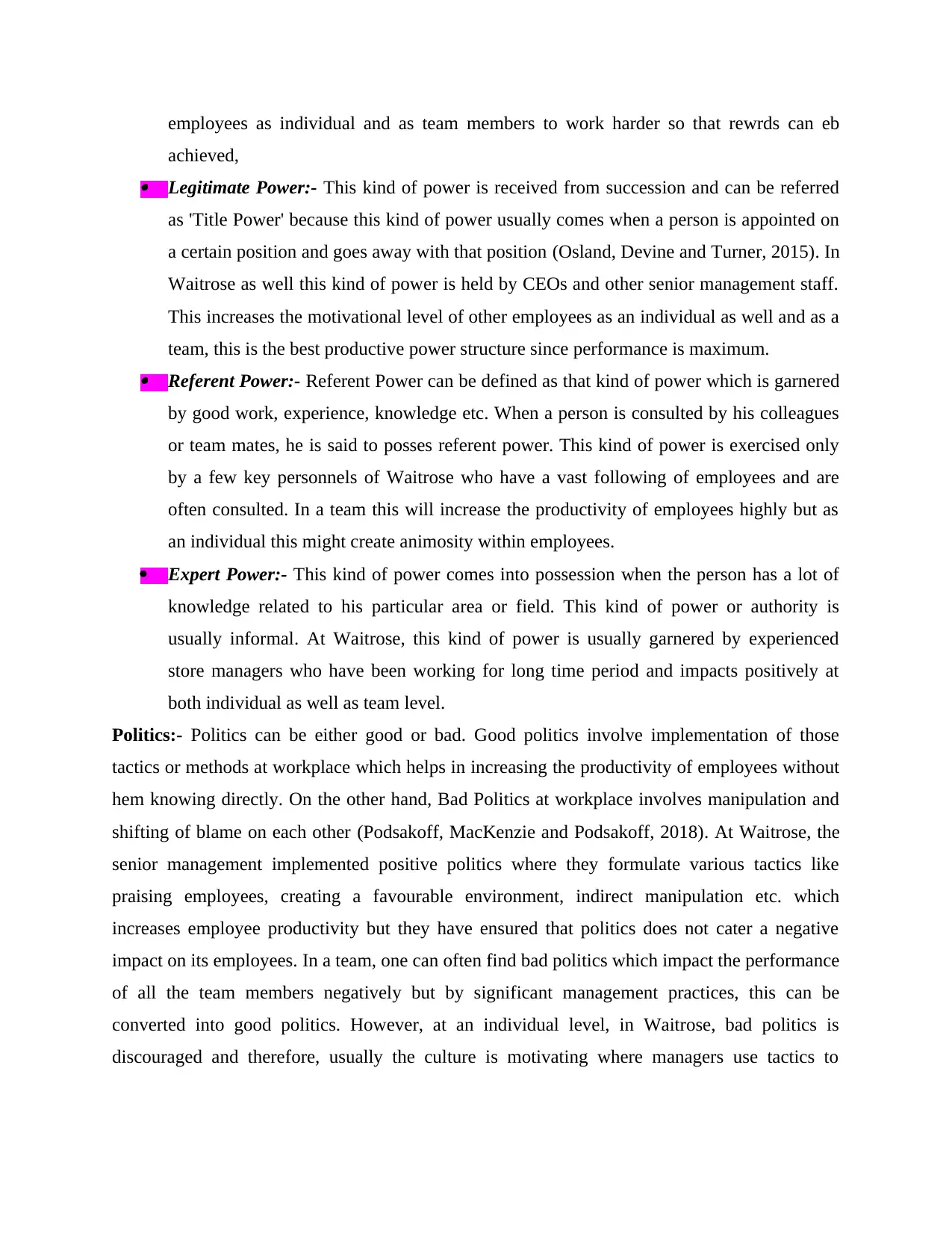
employees as individual and as team members to work harder so that rewrds can eb
achieved, Legitimate Power:- This kind of power is received from succession and can be referred
as 'Title Power' because this kind of power usually comes when a person is appointed on
a certain position and goes away with that position (Osland, Devine and Turner, 2015). In
Waitrose as well this kind of power is held by CEOs and other senior management staff.
This increases the motivational level of other employees as an individual as well and as a
team, this is the best productive power structure since performance is maximum. Referent Power:- Referent Power can be defined as that kind of power which is garnered
by good work, experience, knowledge etc. When a person is consulted by his colleagues
or team mates, he is said to posses referent power. This kind of power is exercised only
by a few key personnels of Waitrose who have a vast following of employees and are
often consulted. In a team this will increase the productivity of employees highly but as
an individual this might create animosity within employees.
Expert Power:- This kind of power comes into possession when the person has a lot of
knowledge related to his particular area or field. This kind of power or authority is
usually informal. At Waitrose, this kind of power is usually garnered by experienced
store managers who have been working for long time period and impacts positively at
both individual as well as team level.
Politics:- Politics can be either good or bad. Good politics involve implementation of those
tactics or methods at workplace which helps in increasing the productivity of employees without
hem knowing directly. On the other hand, Bad Politics at workplace involves manipulation and
shifting of blame on each other (Podsakoff, MacKenzie and Podsakoff, 2018). At Waitrose, the
senior management implemented positive politics where they formulate various tactics like
praising employees, creating a favourable environment, indirect manipulation etc. which
increases employee productivity but they have ensured that politics does not cater a negative
impact on its employees. In a team, one can often find bad politics which impact the performance
of all the team members negatively but by significant management practices, this can be
converted into good politics. However, at an individual level, in Waitrose, bad politics is
discouraged and therefore, usually the culture is motivating where managers use tactics to
achieved, Legitimate Power:- This kind of power is received from succession and can be referred
as 'Title Power' because this kind of power usually comes when a person is appointed on
a certain position and goes away with that position (Osland, Devine and Turner, 2015). In
Waitrose as well this kind of power is held by CEOs and other senior management staff.
This increases the motivational level of other employees as an individual as well and as a
team, this is the best productive power structure since performance is maximum. Referent Power:- Referent Power can be defined as that kind of power which is garnered
by good work, experience, knowledge etc. When a person is consulted by his colleagues
or team mates, he is said to posses referent power. This kind of power is exercised only
by a few key personnels of Waitrose who have a vast following of employees and are
often consulted. In a team this will increase the productivity of employees highly but as
an individual this might create animosity within employees.
Expert Power:- This kind of power comes into possession when the person has a lot of
knowledge related to his particular area or field. This kind of power or authority is
usually informal. At Waitrose, this kind of power is usually garnered by experienced
store managers who have been working for long time period and impacts positively at
both individual as well as team level.
Politics:- Politics can be either good or bad. Good politics involve implementation of those
tactics or methods at workplace which helps in increasing the productivity of employees without
hem knowing directly. On the other hand, Bad Politics at workplace involves manipulation and
shifting of blame on each other (Podsakoff, MacKenzie and Podsakoff, 2018). At Waitrose, the
senior management implemented positive politics where they formulate various tactics like
praising employees, creating a favourable environment, indirect manipulation etc. which
increases employee productivity but they have ensured that politics does not cater a negative
impact on its employees. In a team, one can often find bad politics which impact the performance
of all the team members negatively but by significant management practices, this can be
converted into good politics. However, at an individual level, in Waitrose, bad politics is
discouraged and therefore, usually the culture is motivating where managers use tactics to
⊘ This is a preview!⊘
Do you want full access?
Subscribe today to unlock all pages.

Trusted by 1+ million students worldwide
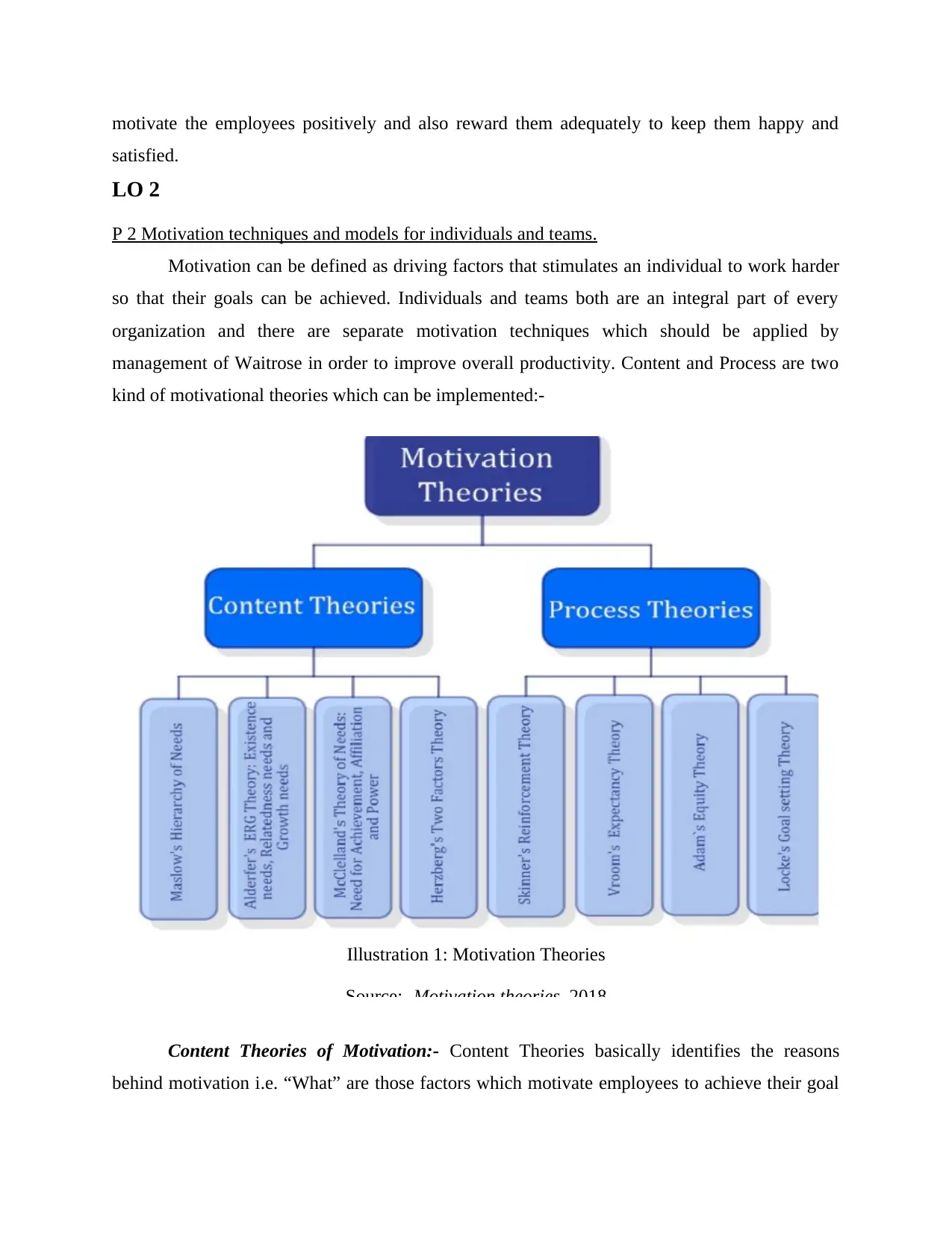
motivate the employees positively and also reward them adequately to keep them happy and
satisfied.
LO 2
P 2 Motivation techniques and models for individuals and teams.
Motivation can be defined as driving factors that stimulates an individual to work harder
so that their goals can be achieved. Individuals and teams both are an integral part of every
organization and there are separate motivation techniques which should be applied by
management of Waitrose in order to improve overall productivity. Content and Process are two
kind of motivational theories which can be implemented:-
Content Theories of Motivation:- Content Theories basically identifies the reasons
behind motivation i.e. “What” are those factors which motivate employees to achieve their goal
Illustration 1: Motivation Theories
Source:- Motivation theories, 2018
satisfied.
LO 2
P 2 Motivation techniques and models for individuals and teams.
Motivation can be defined as driving factors that stimulates an individual to work harder
so that their goals can be achieved. Individuals and teams both are an integral part of every
organization and there are separate motivation techniques which should be applied by
management of Waitrose in order to improve overall productivity. Content and Process are two
kind of motivational theories which can be implemented:-
Content Theories of Motivation:- Content Theories basically identifies the reasons
behind motivation i.e. “What” are those factors which motivate employees to achieve their goal
Illustration 1: Motivation Theories
Source:- Motivation theories, 2018
Paraphrase This Document
Need a fresh take? Get an instant paraphrase of this document with our AI Paraphraser
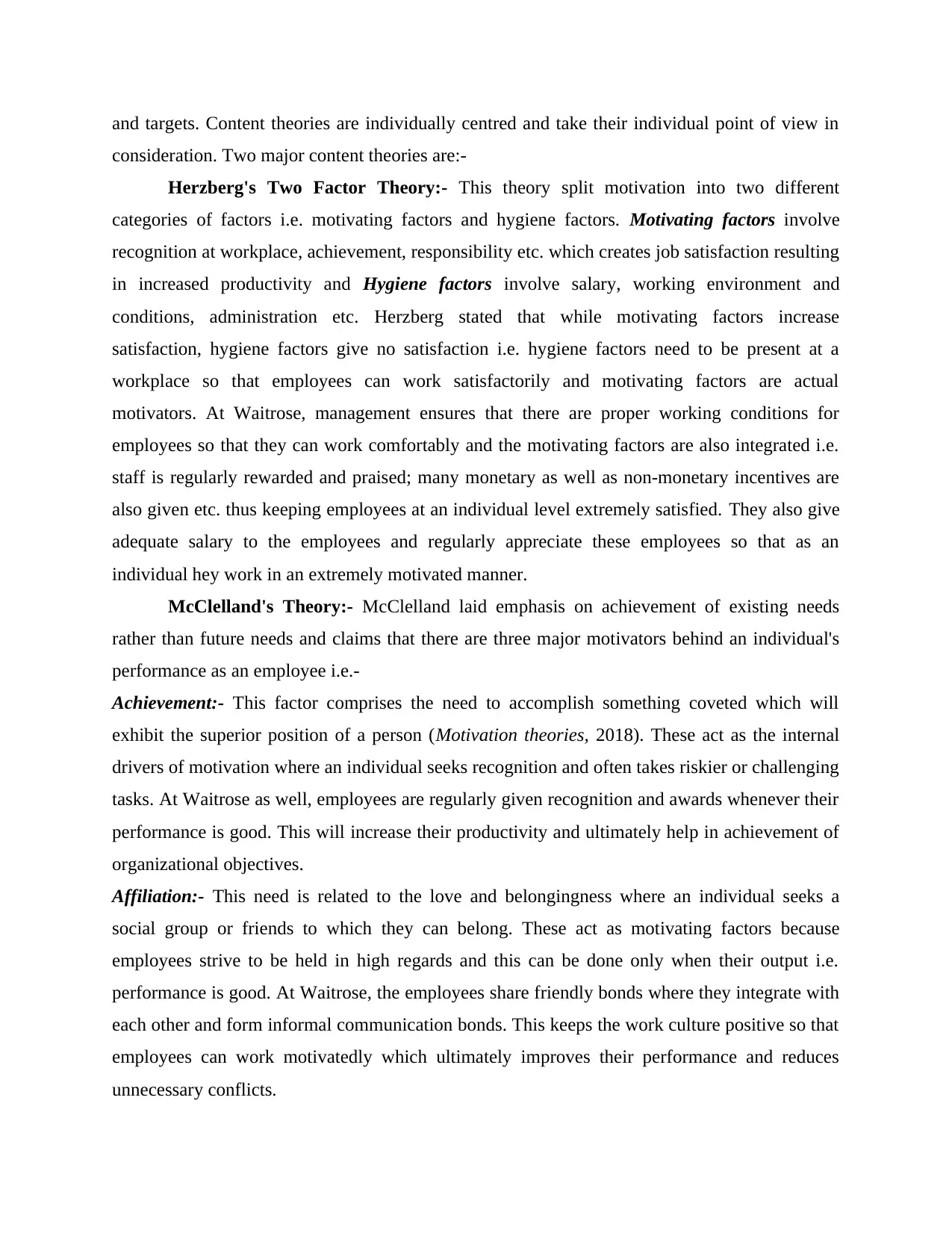
and targets. Content theories are individually centred and take their individual point of view in
consideration. Two major content theories are:-
Herzberg's Two Factor Theory:- This theory split motivation into two different
categories of factors i.e. motivating factors and hygiene factors. Motivating factors involve
recognition at workplace, achievement, responsibility etc. which creates job satisfaction resulting
in increased productivity and Hygiene factors involve salary, working environment and
conditions, administration etc. Herzberg stated that while motivating factors increase
satisfaction, hygiene factors give no satisfaction i.e. hygiene factors need to be present at a
workplace so that employees can work satisfactorily and motivating factors are actual
motivators. At Waitrose, management ensures that there are proper working conditions for
employees so that they can work comfortably and the motivating factors are also integrated i.e.
staff is regularly rewarded and praised; many monetary as well as non-monetary incentives are
also given etc. thus keeping employees at an individual level extremely satisfied. They also give
adequate salary to the employees and regularly appreciate these employees so that as an
individual hey work in an extremely motivated manner.
McClelland's Theory:- McClelland laid emphasis on achievement of existing needs
rather than future needs and claims that there are three major motivators behind an individual's
performance as an employee i.e.-
Achievement:- This factor comprises the need to accomplish something coveted which will
exhibit the superior position of a person (Motivation theories, 2018). These act as the internal
drivers of motivation where an individual seeks recognition and often takes riskier or challenging
tasks. At Waitrose as well, employees are regularly given recognition and awards whenever their
performance is good. This will increase their productivity and ultimately help in achievement of
organizational objectives.
Affiliation:- This need is related to the love and belongingness where an individual seeks a
social group or friends to which they can belong. These act as motivating factors because
employees strive to be held in high regards and this can be done only when their output i.e.
performance is good. At Waitrose, the employees share friendly bonds where they integrate with
each other and form informal communication bonds. This keeps the work culture positive so that
employees can work motivatedly which ultimately improves their performance and reduces
unnecessary conflicts.
consideration. Two major content theories are:-
Herzberg's Two Factor Theory:- This theory split motivation into two different
categories of factors i.e. motivating factors and hygiene factors. Motivating factors involve
recognition at workplace, achievement, responsibility etc. which creates job satisfaction resulting
in increased productivity and Hygiene factors involve salary, working environment and
conditions, administration etc. Herzberg stated that while motivating factors increase
satisfaction, hygiene factors give no satisfaction i.e. hygiene factors need to be present at a
workplace so that employees can work satisfactorily and motivating factors are actual
motivators. At Waitrose, management ensures that there are proper working conditions for
employees so that they can work comfortably and the motivating factors are also integrated i.e.
staff is regularly rewarded and praised; many monetary as well as non-monetary incentives are
also given etc. thus keeping employees at an individual level extremely satisfied. They also give
adequate salary to the employees and regularly appreciate these employees so that as an
individual hey work in an extremely motivated manner.
McClelland's Theory:- McClelland laid emphasis on achievement of existing needs
rather than future needs and claims that there are three major motivators behind an individual's
performance as an employee i.e.-
Achievement:- This factor comprises the need to accomplish something coveted which will
exhibit the superior position of a person (Motivation theories, 2018). These act as the internal
drivers of motivation where an individual seeks recognition and often takes riskier or challenging
tasks. At Waitrose as well, employees are regularly given recognition and awards whenever their
performance is good. This will increase their productivity and ultimately help in achievement of
organizational objectives.
Affiliation:- This need is related to the love and belongingness where an individual seeks a
social group or friends to which they can belong. These act as motivating factors because
employees strive to be held in high regards and this can be done only when their output i.e.
performance is good. At Waitrose, the employees share friendly bonds where they integrate with
each other and form informal communication bonds. This keeps the work culture positive so that
employees can work motivatedly which ultimately improves their performance and reduces
unnecessary conflicts.

Power:- This third factor, i.e. the need to control and regulate the subordinates and exercise some
kind of control over them often motivates an individual to work harder (Stewart, Courtright and
Manz, 2019). They intend to work hard so that they can achieve that position which will give
him the authority and power that he covets. At Waitrose, the power delegation is great where
employees have the authority that they require based on the position that they are and the job role
that they are assigned with. In order to accomplish theb objecticves, it is extremely necessary to
implemente appropriate power and authority on employees so that they can work in a productive
manner and achieve the goals.
Process Theories:- Process theories are basically those theories that address “How” part
i.e. how an employee can be motivated and are usually formulated in a process i.e. a series of
steps that need to be followed in order to implement such theories. There are two major process
theories which can be applied at Waitrose:-
Vroom's Expectancy Theory:- As per Vroom, Motivation can be defined as a process through
which decision to select one alternative out of all the available ones are made. There are three
major parts i.e. expectancy, instrumentality and valence which collectively motivates the entire
team to increase their productivity.
Expectancy defines the belief that if an employee works harder, they will be able to
succeed more thus getting appraisals and when employee's individual performance increases, the
performance of Waitrose as a whole automatically improves.
Instrumentality is defined as how attractive the reward that is promised to an employee is
or how hard he will work in order to achieve that reward (Vasu, Stewart and Garson, 2017).
When an employee formulates an aim to achieve that reward, he will improve his performance
and this will automatically result in improved performance of Waitrose.
Valence can be defined as the importance that an employee places on achievement of
rewards and its value. When the value for such reward will be high, they will try harder to
achieve these goals. This will again directly influence the performance of Waitrose overall.
Adam's Equity Theory:- This theory emphasizes that managers need to treat their employees
equitably i.e. the input that managers expect form employees should be equivalent to the output
that employees expect. The reward should be as per the tasks that have been assigned to them.
When this output input ratio is balanced, employees are automatically motivated to work harder.
Input at Waitrose involves, the skills, experience, knowledge, flexibility etc. and output at
kind of control over them often motivates an individual to work harder (Stewart, Courtright and
Manz, 2019). They intend to work hard so that they can achieve that position which will give
him the authority and power that he covets. At Waitrose, the power delegation is great where
employees have the authority that they require based on the position that they are and the job role
that they are assigned with. In order to accomplish theb objecticves, it is extremely necessary to
implemente appropriate power and authority on employees so that they can work in a productive
manner and achieve the goals.
Process Theories:- Process theories are basically those theories that address “How” part
i.e. how an employee can be motivated and are usually formulated in a process i.e. a series of
steps that need to be followed in order to implement such theories. There are two major process
theories which can be applied at Waitrose:-
Vroom's Expectancy Theory:- As per Vroom, Motivation can be defined as a process through
which decision to select one alternative out of all the available ones are made. There are three
major parts i.e. expectancy, instrumentality and valence which collectively motivates the entire
team to increase their productivity.
Expectancy defines the belief that if an employee works harder, they will be able to
succeed more thus getting appraisals and when employee's individual performance increases, the
performance of Waitrose as a whole automatically improves.
Instrumentality is defined as how attractive the reward that is promised to an employee is
or how hard he will work in order to achieve that reward (Vasu, Stewart and Garson, 2017).
When an employee formulates an aim to achieve that reward, he will improve his performance
and this will automatically result in improved performance of Waitrose.
Valence can be defined as the importance that an employee places on achievement of
rewards and its value. When the value for such reward will be high, they will try harder to
achieve these goals. This will again directly influence the performance of Waitrose overall.
Adam's Equity Theory:- This theory emphasizes that managers need to treat their employees
equitably i.e. the input that managers expect form employees should be equivalent to the output
that employees expect. The reward should be as per the tasks that have been assigned to them.
When this output input ratio is balanced, employees are automatically motivated to work harder.
Input at Waitrose involves, the skills, experience, knowledge, flexibility etc. and output at
⊘ This is a preview!⊘
Do you want full access?
Subscribe today to unlock all pages.

Trusted by 1+ million students worldwide
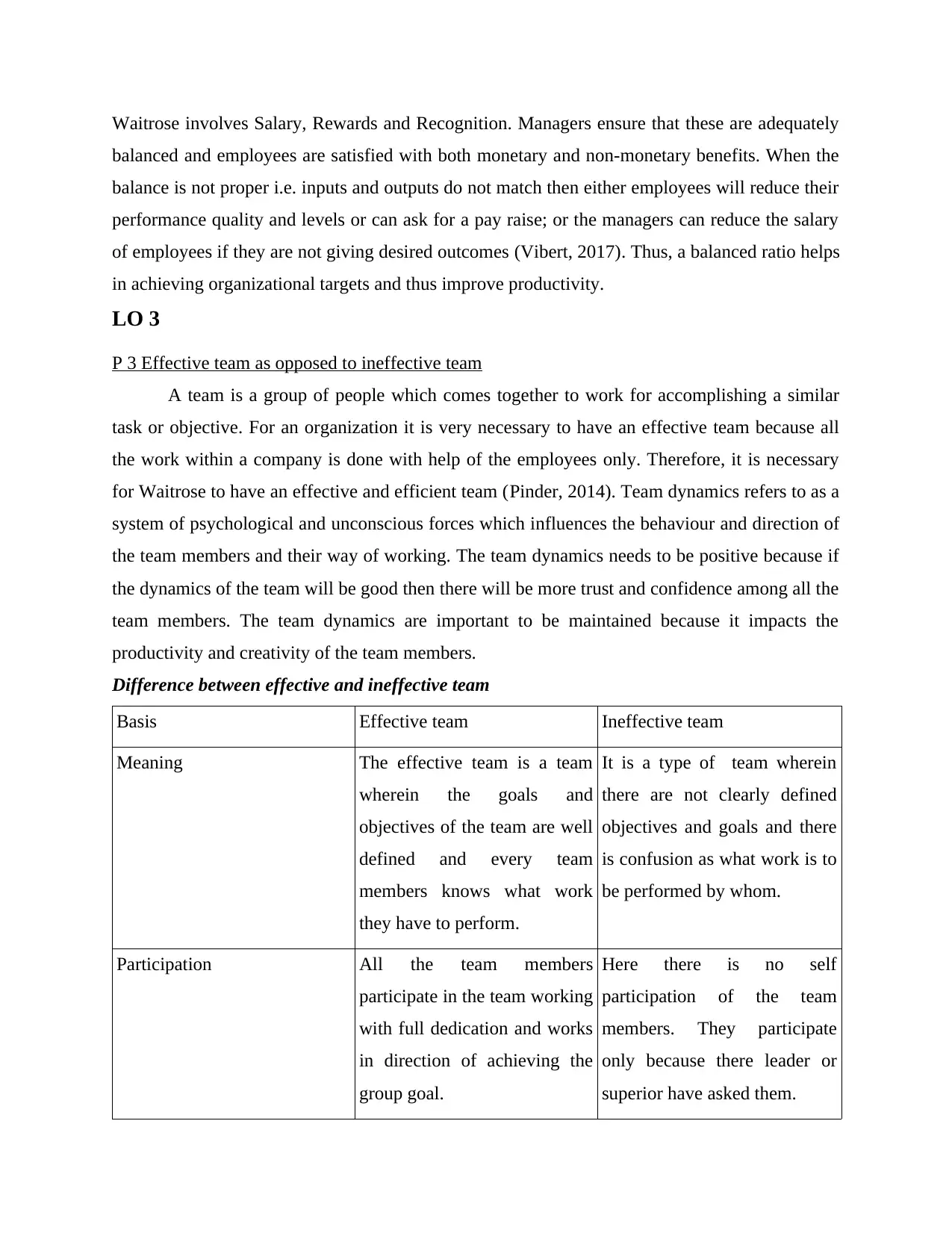
Waitrose involves Salary, Rewards and Recognition. Managers ensure that these are adequately
balanced and employees are satisfied with both monetary and non-monetary benefits. When the
balance is not proper i.e. inputs and outputs do not match then either employees will reduce their
performance quality and levels or can ask for a pay raise; or the managers can reduce the salary
of employees if they are not giving desired outcomes (Vibert, 2017). Thus, a balanced ratio helps
in achieving organizational targets and thus improve productivity.
LO 3
P 3 Effective team as opposed to ineffective team
A team is a group of people which comes together to work for accomplishing a similar
task or objective. For an organization it is very necessary to have an effective team because all
the work within a company is done with help of the employees only. Therefore, it is necessary
for Waitrose to have an effective and efficient team (Pinder, 2014). Team dynamics refers to as a
system of psychological and unconscious forces which influences the behaviour and direction of
the team members and their way of working. The team dynamics needs to be positive because if
the dynamics of the team will be good then there will be more trust and confidence among all the
team members. The team dynamics are important to be maintained because it impacts the
productivity and creativity of the team members.
Difference between effective and ineffective team
Basis Effective team Ineffective team
Meaning The effective team is a team
wherein the goals and
objectives of the team are well
defined and every team
members knows what work
they have to perform.
It is a type of team wherein
there are not clearly defined
objectives and goals and there
is confusion as what work is to
be performed by whom.
Participation All the team members
participate in the team working
with full dedication and works
in direction of achieving the
group goal.
Here there is no self
participation of the team
members. They participate
only because there leader or
superior have asked them.
balanced and employees are satisfied with both monetary and non-monetary benefits. When the
balance is not proper i.e. inputs and outputs do not match then either employees will reduce their
performance quality and levels or can ask for a pay raise; or the managers can reduce the salary
of employees if they are not giving desired outcomes (Vibert, 2017). Thus, a balanced ratio helps
in achieving organizational targets and thus improve productivity.
LO 3
P 3 Effective team as opposed to ineffective team
A team is a group of people which comes together to work for accomplishing a similar
task or objective. For an organization it is very necessary to have an effective team because all
the work within a company is done with help of the employees only. Therefore, it is necessary
for Waitrose to have an effective and efficient team (Pinder, 2014). Team dynamics refers to as a
system of psychological and unconscious forces which influences the behaviour and direction of
the team members and their way of working. The team dynamics needs to be positive because if
the dynamics of the team will be good then there will be more trust and confidence among all the
team members. The team dynamics are important to be maintained because it impacts the
productivity and creativity of the team members.
Difference between effective and ineffective team
Basis Effective team Ineffective team
Meaning The effective team is a team
wherein the goals and
objectives of the team are well
defined and every team
members knows what work
they have to perform.
It is a type of team wherein
there are not clearly defined
objectives and goals and there
is confusion as what work is to
be performed by whom.
Participation All the team members
participate in the team working
with full dedication and works
in direction of achieving the
group goal.
Here there is no self
participation of the team
members. They participate
only because there leader or
superior have asked them.
Paraphrase This Document
Need a fresh take? Get an instant paraphrase of this document with our AI Paraphraser
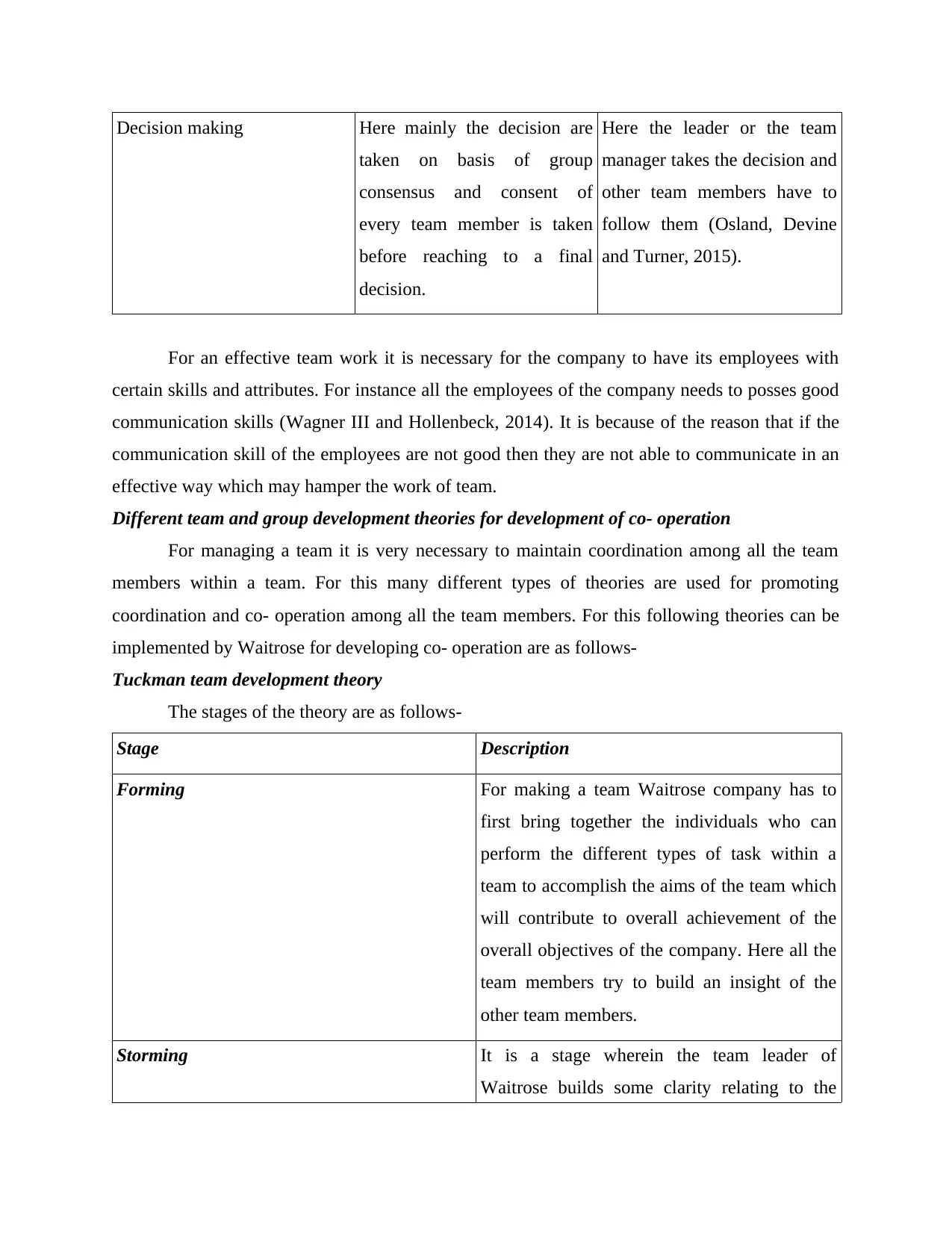
Decision making Here mainly the decision are
taken on basis of group
consensus and consent of
every team member is taken
before reaching to a final
decision.
Here the leader or the team
manager takes the decision and
other team members have to
follow them (Osland, Devine
and Turner, 2015).
For an effective team work it is necessary for the company to have its employees with
certain skills and attributes. For instance all the employees of the company needs to posses good
communication skills (Wagner III and Hollenbeck, 2014). It is because of the reason that if the
communication skill of the employees are not good then they are not able to communicate in an
effective way which may hamper the work of team.
Different team and group development theories for development of co- operation
For managing a team it is very necessary to maintain coordination among all the team
members within a team. For this many different types of theories are used for promoting
coordination and co- operation among all the team members. For this following theories can be
implemented by Waitrose for developing co- operation are as follows-
Tuckman team development theory
The stages of the theory are as follows-
Stage Description
Forming For making a team Waitrose company has to
first bring together the individuals who can
perform the different types of task within a
team to accomplish the aims of the team which
will contribute to overall achievement of the
overall objectives of the company. Here all the
team members try to build an insight of the
other team members.
Storming It is a stage wherein the team leader of
Waitrose builds some clarity relating to the
taken on basis of group
consensus and consent of
every team member is taken
before reaching to a final
decision.
Here the leader or the team
manager takes the decision and
other team members have to
follow them (Osland, Devine
and Turner, 2015).
For an effective team work it is necessary for the company to have its employees with
certain skills and attributes. For instance all the employees of the company needs to posses good
communication skills (Wagner III and Hollenbeck, 2014). It is because of the reason that if the
communication skill of the employees are not good then they are not able to communicate in an
effective way which may hamper the work of team.
Different team and group development theories for development of co- operation
For managing a team it is very necessary to maintain coordination among all the team
members within a team. For this many different types of theories are used for promoting
coordination and co- operation among all the team members. For this following theories can be
implemented by Waitrose for developing co- operation are as follows-
Tuckman team development theory
The stages of the theory are as follows-
Stage Description
Forming For making a team Waitrose company has to
first bring together the individuals who can
perform the different types of task within a
team to accomplish the aims of the team which
will contribute to overall achievement of the
overall objectives of the company. Here all the
team members try to build an insight of the
other team members.
Storming It is a stage wherein the team leader of
Waitrose builds some clarity relating to the
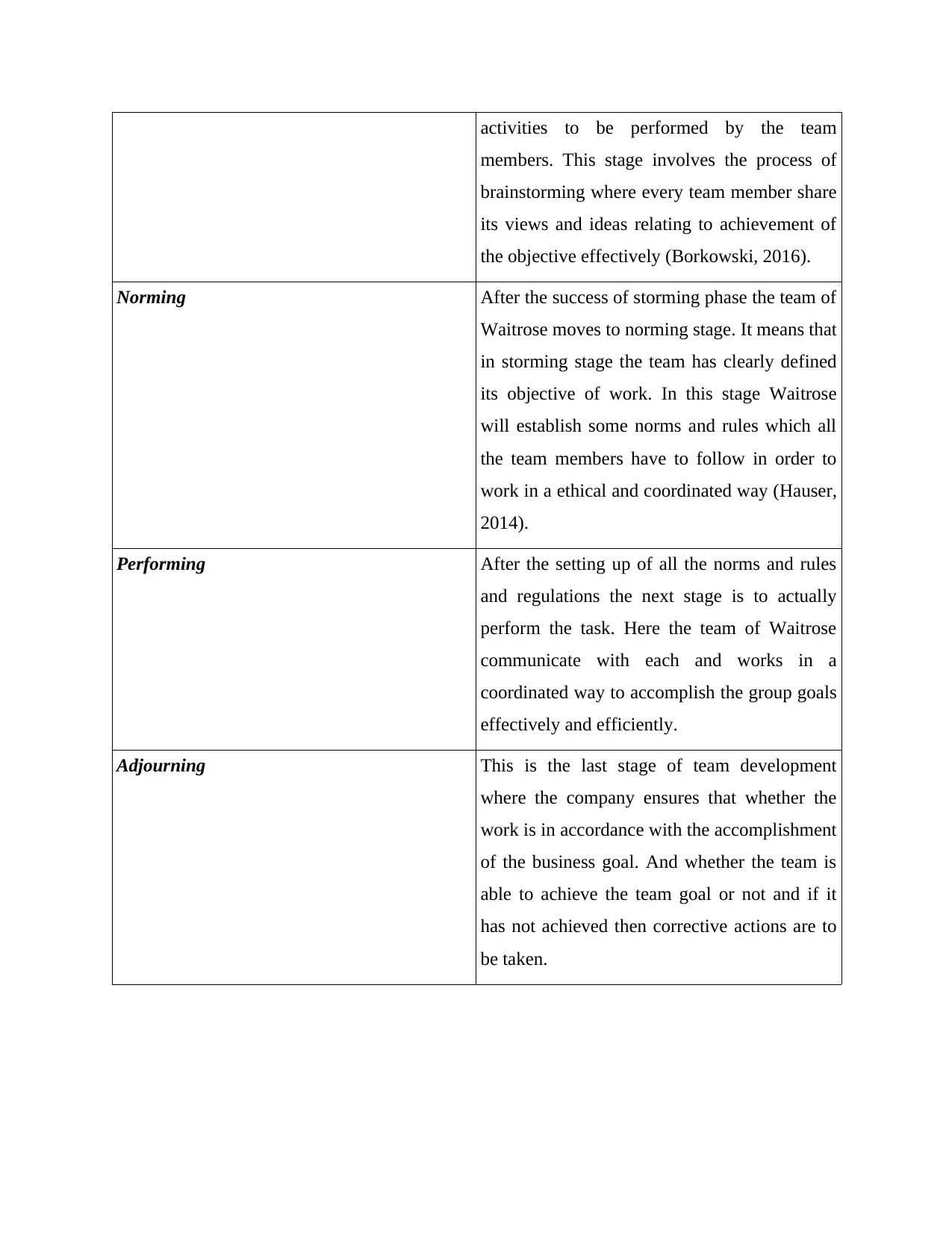
activities to be performed by the team
members. This stage involves the process of
brainstorming where every team member share
its views and ideas relating to achievement of
the objective effectively (Borkowski, 2016).
Norming After the success of storming phase the team of
Waitrose moves to norming stage. It means that
in storming stage the team has clearly defined
its objective of work. In this stage Waitrose
will establish some norms and rules which all
the team members have to follow in order to
work in a ethical and coordinated way (Hauser,
2014).
Performing After the setting up of all the norms and rules
and regulations the next stage is to actually
perform the task. Here the team of Waitrose
communicate with each and works in a
coordinated way to accomplish the group goals
effectively and efficiently.
Adjourning This is the last stage of team development
where the company ensures that whether the
work is in accordance with the accomplishment
of the business goal. And whether the team is
able to achieve the team goal or not and if it
has not achieved then corrective actions are to
be taken.
members. This stage involves the process of
brainstorming where every team member share
its views and ideas relating to achievement of
the objective effectively (Borkowski, 2016).
Norming After the success of storming phase the team of
Waitrose moves to norming stage. It means that
in storming stage the team has clearly defined
its objective of work. In this stage Waitrose
will establish some norms and rules which all
the team members have to follow in order to
work in a ethical and coordinated way (Hauser,
2014).
Performing After the setting up of all the norms and rules
and regulations the next stage is to actually
perform the task. Here the team of Waitrose
communicate with each and works in a
coordinated way to accomplish the group goals
effectively and efficiently.
Adjourning This is the last stage of team development
where the company ensures that whether the
work is in accordance with the accomplishment
of the business goal. And whether the team is
able to achieve the team goal or not and if it
has not achieved then corrective actions are to
be taken.
⊘ This is a preview!⊘
Do you want full access?
Subscribe today to unlock all pages.

Trusted by 1+ million students worldwide
1 out of 20
Related Documents
Your All-in-One AI-Powered Toolkit for Academic Success.
+13062052269
info@desklib.com
Available 24*7 on WhatsApp / Email
![[object Object]](/_next/static/media/star-bottom.7253800d.svg)
Unlock your academic potential
Copyright © 2020–2025 A2Z Services. All Rights Reserved. Developed and managed by ZUCOL.




